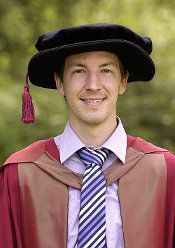Stress Trajectories Element Method and its Modifications for Potential Problems Reconstruction Juraj Irsa has recently passed his PhD viva at the Wessex Institute of Technology with a thesis entitled ‘Stress Trajectories Element Method and its Modifications for Potential Problems Reconstruction’. His external examiner was Prof. Daniel Lesnic from the University of Leeds and the internal examiner was Prof. Viktor Popov.
Juraj Irsa has recently passed his PhD viva at the Wessex Institute of Technology with a thesis entitled ‘Stress Trajectories Element Method and its Modifications for Potential Problems Reconstruction’. His external examiner was Prof. Daniel Lesnic from the University of Leeds and the internal examiner was Prof. Viktor Popov.
Juraj Irsa received his Master of Science from the Slovak Technical University in the field of Applied Mechanics. He came to WIT in 2008 and started a PhD programme under the supervision of Prof. Alexander N. Galybin.
His work focused on the development of a new computational method able to deal with high noise and irregular experimental data in the Earth's crust. The combination of the type of available data, its irregular distribution and high errors restrict the use of the common computational methods. The available data are on the principal directions only, which come from experimental measurements. The developed method coupled the Trefftz method and discretization with the use of collocation points. There is no need for prior manipulation of the experimental data, as these are used in the technique directly. The domain, consisting of many tectonic plates is discretized into subdomains where the approximating functions satisfy the governing equations. The method is able to obtain the whole stress field, such as stress trajectories, mean and maximum shear stress and also the missing boundary conditions on the tectonic plate boundaries in terms of normal and shear stress, which is very useful for the further use and validation of existing values. The method has shown to be very efficient not only in determining the stress field, but also in determining the zones with high potential of tsunamigenic activity in case of an earthquake.
In addition, the method has been generalized and modified to other problems in science and engineering, such as elasticity, heat flow, fluid flow, galvanic corrosion and elastostatics. There is not a restriction to a particular type of data. It can be used for reconstruction problems with limited data, boundary value problems, and also for inverse problems with data subjected to large errors. A comparison with the FEM and the meshless RBF have also been tested and proved the STEM to be efficient, especially in the case of reconstruction problems.
Both examiners congratulated Juraj on the work presented and recommended that he be awarded the degree Doctor of Philosophy.

 Wessex Institute
Wessex Institute